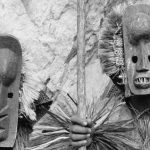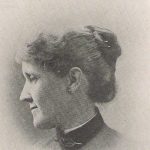One evening, in the latter part of March, Mr. Roff was sitting in the room waiting for tea, and reading the paper, Mary being out in the yard. He asked Mrs. Roff if she could find a certain velvet head-dress that Mary used to wear the last year before she died. If so, to lay it on the stand and say nothing about it, to see if Mary would recognize it. Mrs. Roff readily found and laid it on the stand.
The girl soon came in, and immediately exclaimed as she approached the stand, “Oh, there is my head-dress I wore when my hair was short!” She then asked, “Ma, where is my box of letters? Have you got them yet?” Mrs. Roff replied, “Yes, Mary, I have some of them.” She at once got the box with many letters in it. As Mary began to examine them she said, “Oh, ma, here is a collar I tatted! Ma, why did you not show to me my letters and things before?” The collar had been preserved among the relics of the lamented child as one of the beautiful things her fingers had wrought before Lurancy was born, and so Mary continually recognized every little thing and remembered every little incident of her girl-hood….
In conversation with the writer about her former life, she spoke of cutting her arm as hereinbefore stated, and asked if he ever saw where she did it. On receiving a negative answer, she proceeded to slip up her sleeve as if to exhibit the scar, but suddenly arrested the movement, as if by a sudden thought, and quickly said, “Oh, this is not the arm; that one is in the ground,” and proceeded to tell where it was buried, and how she saw it done, and who stood around, how they felt, &c., but she did not feel bad. I heard her tell Mr. Roff and the friends present, how she wrote to him a message some years ago through the hand of a medium, giving name, time, and place. Also of rapping and of spelling out a message by another medium, giving time, name, place, &c., &c. which the parents admitted to be all true….
During her stay at Mr. Roff’s her physical condition continually improved, being under the care and treatment of her supposed parents and the advice and help of her physician. She was ever obedient to the government and rules of the family, like a careful and wise child, always keeping in the company of some of the family, unless to go in to the nearest neighbours across the street. She was often invited and went with Mrs. Roff to visit the first families of the city, who soon became satisfied that the girl was not crazy, but a fine, well-mannered child.
As the time drew near for the restoration of Lurancy to her parents and home, Mary would sometimes seem to recede into the memory and manner of Lurancy for a little time, yet not enough to lose her identity or permit the manifestation of Lurancy’s mind, but enough to show she was impressing her presence upon her own body.
On May 19th, in the presence of Henry Vennum, Lurancy’s brother, Mary left control for a time, and “Lurancy took full possession of her own bod recognizing Henry as her brother. The change of control occurred again when Mrs. Vennum came to see her the same day.
On the morning of May 21st Mr. Roff writes as follows: —
“Mary is to leave the body of Rancy to-day, about eleven o’clock, so she says. She is bidding neighbours and friends good-bye. Rancy to return home all right to-day. Mary came from her room upstairs, where she was sleeping with Lottie, at ten o’clock last night, lay down by us, hugged and kissed us, and cried because she must bid us good-bye, telling us to give all her pictures, marbles, and cards, and twenty-five cents Mrs. Vennum had given her to Rancy, and had us promise to visit Rancy often.”
Mary arranged that her sister, Mrs. Alter, should come to the house to say good-bye to her, and that when Lurancy came at eleven o’clock she should take her to Mr. Roff’s office, and he would go to Mr. Vennum’s with her. There was some alternation of the control on the way, but the final return of the normal Lurancy Vennum took place before they reached Mr. Roff’s office, and on arriving at her own home she recognized all the members of her own family as such, and was perfectly well and happy in her own surroundings. A few days later, on meeting Dr. Stevens, under whose care she had been at Mr. Roff’s house, she had to be introduced to him as an entire stranger, and treated him as such. The next day she came to him spontaneously, saying Mary Roff had told her to come and meet him, and had made her feel he had been a very kind friend to her, and she gave him a long message purporting to be from Mary.
In 1890, Richard Hodgson visited Watseka and interviewed many of the principle witnesses of this case. Their testimony was in agreement with Dr. Stevens’ presentation. However, Hodgson was unable to get in touch with Lurancy Vennum herself. He draws the following conclusions to the case:
I have no doubt that the incidents occurred substantially as described in the narrative by Dr. Stevens, and in my view the only other interpretation of the case — besides the spiritistic — that seems at all plausible is that which has been put forward as the alternative to the spiritistic theory to account for the trance-communications of Mrs. Piper and similar cases, viz., secondary personality with supernormal powers. It would be difficult to disprove this hypothesis in the case of the Watseka Wonder, owing to the comparative meagreness of the record and the probable abundance of “suggestion” in the environment, and any conclusion that we may reach would probably be determined largely by our convictions concerning other cases. My personal opinion is that the “Watseka Wonder” case belongs in the main manifestations to the spiritistic category.







